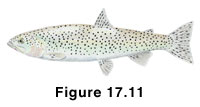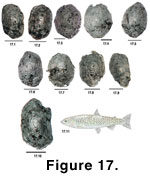 Description
DescriptionOncorhynchus clarki clarki (Coastal
Cutthroat Trout)
(Other common names: Red-Throated Trout, Clark's Trout)
Figure 17.11
 Description
DescriptionLength: up to 76 cm (listed from a non-migrating specimen).
Mouth: large, terminal, directed forward; upper jaw extends beyond the posterior edge of orbit; lips fleshy, jaws are even with red-orange streaks on the lower inner edge; teeth in jaws small, well developed, conical and hooked inwards on the maxillaries, premaxillaries, mandibles, the shaft of vomer and the back of the tongue.
Body: elongate; caudal peduncle moderately compressed; caudal fin slightly forked; adipose fin small and slender; 15-22 gill rakers over the first gill arch.
Color: green-blue on dorsal with silver sides; in irregular rows on the back, sides and belly are angular black spots; black spots also on pectoral fins; seagoing individuals are more silvery with yellow on the flanks and fins.
Depth: pelagic schooling species.
Habitat: usually a freshwater species in lakes but is anadromous in some coastal streams.
Season: spawning occurs in early spring (February-March), young may head to sea or remain in the estuaries moving between the inlets and coastal waters.
Diet: other forage fish species (e.g., juvenile salmon, rockfish, sculpins, flatfish), crustaceans, and insects.
Predators: larger fish species including other salmon (on young), sea birds, marine mammals, and terrestrial mammals.
Distribution: northern California to Alaska.
 Scale
Description
Scale
DescriptionRelative Size of Scale: small.
Position of Scales on Body: above lateral line canal 115-161 in oblique rows (Hart, 1973).
Overall Scale Shape: circular to somewhat oval with a smooth outside edge.
Focus and Circuli: focus is clearly defined and often centralized between the fields; the posterior field is not transparent as in other salmon species. The fields are less distinct (look for pigmented tissue on the posterior field); circuli are generally continuous between the anterior and lateral fields. Circuli are present in the posterior field, are both continuous and discontinuous, and are less compacted.
Radii: radii absent.